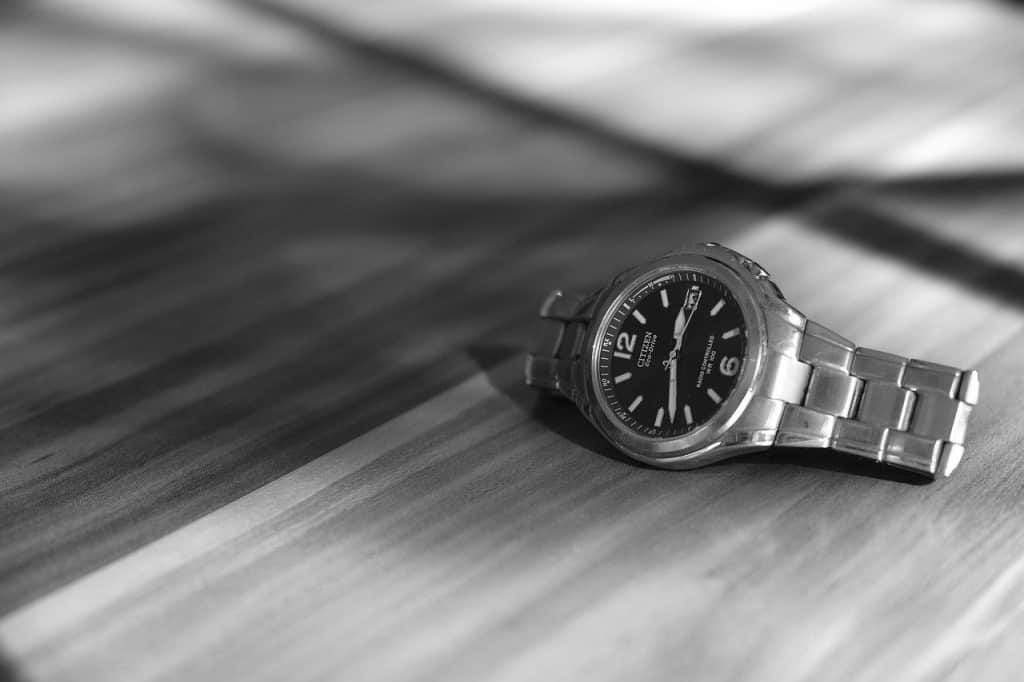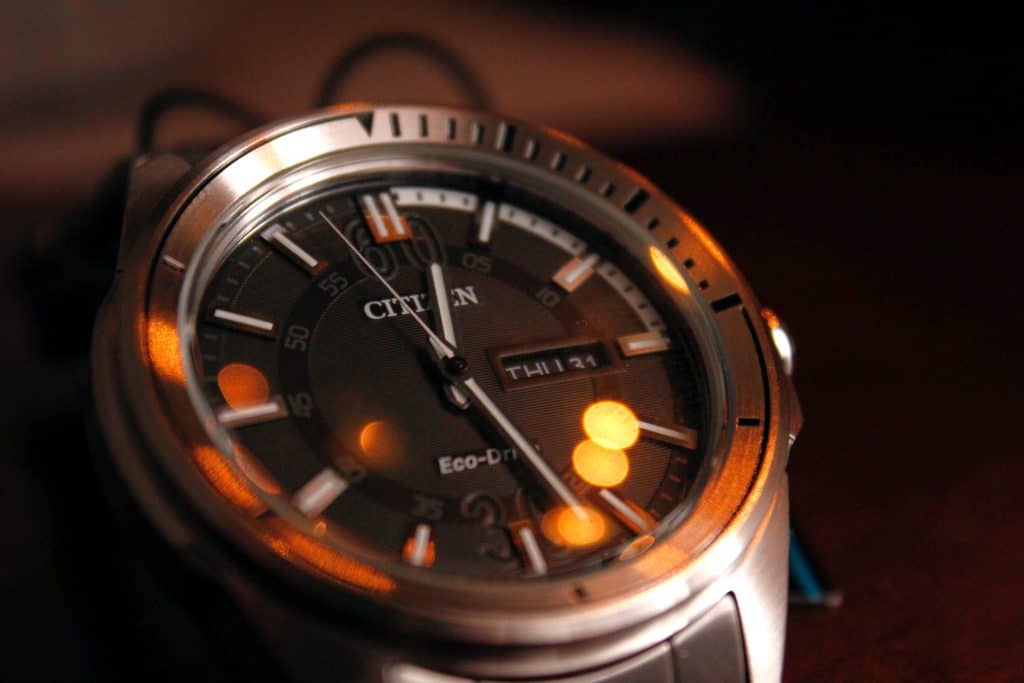
The Citizen Eco-Drive has been on the global scene since 1976, but maybe you just recently added the piece to your watch collection for the first time. Though the Eco-Drive is a light-powered watch, you still might wonder, does it need servicing?
In the general sense, Citizen Eco-Drive watches need to be regularly serviced. Even though they are battery-less, light-powered analog watches, they’re still a watch with many inner workings that need to be taken care of. A service is a general practice for any watch.
In this post, we will discuss why Eco-Drive watches need to be serviced, what parts of your watch to check regularly, and how to tell if your watch needs some maintenance.
Table of Contents
What Is The Citizen Eco-Drive?
The Eco-Drive is the world’s first analog watch powered by light. Citizen was the first to create this technology back in the 1970s, naming it Eco-Drive Technology.
Eco-Drive watches convert sources of natural and artificial light into energy that is stored in a power reserve to power your watch. The timepiece recharges by regularly being exposed to light, though the amount of time it takes to recharge the watch depends on the amount and type of light used.
The nice thing about Citizen Eco-Drive watches, besides not needing to continually repurchase batteries, is that when fully charged, the Eco-Drive will continue to tell time for at least six months, even if then kept in total darkness.
Why Does The Citizen Eco-Drive Need Servicing?
Though the Eco-Drive does not have a traditional battery, it does need servicing every now and then. Parts can become worn-out, the hands may stop keeping time correctly, or maybe you hear sounds coming from the watch you’ve never heard before. These are symptoms that something may be wrong with your watch, so it’s best to take it in for some servicing!
We recommend taking your watch in for regular maintenance every 6 to 12 months, though if something feels “off” or you can see damage or moisture, have it get checked out. Preventing any potential damage is always better than fixing it later on.
Understandably, taking a watch in for service isn’t always very high on the to-do list, but it is vital if you want to prolong the life of your treasured timepieces. If you neglect to service your Eco-Drive–or any watch for that matter–you may have to pay up to fix more parts.
Not servicing your watch on a prolonged basis could result in jumpy, unequal hand movements or a loose dial or screws. Water damage inside the case can lead to rust and decreased lubrication of the hands.
Now you may be thinking about your other watches that haven’t been serviced recently and how they still work. Watches can continue to work despite not being continually serviced, but they last much longer when they are.
Luxury watches tend to need more maintenance than cheaper watches because they are built with more complicated features and intricate designs. Still, servicing a watch isn’t necessarily mandatory, but it is recommended.
What Parts Of An Eco-Drive Watch Need Maintenance?

Eco-Drive watches typically need servicing to replace worn-out button gaskets, gears, casebacks, and solar cells.
If you’re wearing your watch all day, it’s bound to get nicked and bumped just resting on your active wrist. This can wear out your watch’s gaskets and internal gears. The constant movement can also lead to the screws becoming loose, which can result in several broken parts and functions.
Water damage and extreme temperatures can cause them to wear down or even completely break the watch. We recommend reading about the Citizen light and heat guidelines to avoid unnecessary extreme temperature exposure.
To keep water damage at a minimum, try to learn about your watch model’s water-resistance level, too, so you know when to be cautious while doing water-based activities like swimming, kayaking, or diving. This level can differ from watch to watch, where some are only resistant to rain and others can be worn while swimming.
You may notice over time that water, dust, or debris have snuck their way into your watch’s case or onto the caseback. By taking it in for service, your watch will be disassembled, thoroughly cleaned, oiled, and be put back together dirt-free.
Lastly, we mentioned that the Eco-Drive solar cell might need servicing. The solar cells in these watches typically last 20 years or more, but they do lose their power slowly over time. Using a thin Silicon disc placed underneath the dial, this disc changes light energy to electrical energy to keep your watch charged for up to six months. If your watch is no longer holding a charge, take it to a reputable watch technician.
How To Check If Your Watch Needs Servicing
Servicing your watch is always a good idea if you want to prolong your timepiece’s longevity, especially if it’s from prestigious brands like Montblanc, Hublot, or Girard Perregaux. Cheaper watch brands like Seiko and Citizen can typically get away with less servicing.
But what signs should you keep an eye out for to let you know it’s time for service?
Your Watch Doesn’t Keep Time Correctly
One of the most obvious signs that you need to bring your watch to an expert is seeing it no longer tells time correctly. This doesn’t mean being inaccurate (a few seconds off) once in a blue moon, but when you continually notice that the time is wrong, it’s time to have it checked out.
You See Dirt Or Moisture Inside The Case
Dirt and especially damaging moisture are two red flags that your Citizen watch needs to be taken in for care. Water is not supposed to be in your watch case, no matter the brand or watch model.
Saltwater is particularly detrimental to the 100+ tiny parts tucked inside your watch. Saltwater is naturally corrosive, so it doesn’t take much to start rusting up your watch’s mechanics. Just one drop of salt water inside the case is enough to wreak havoc on your timepiece.
In the event you ever notice water inside your watch, take it in for service straight away. Your local watchmaker can hopefully dry out any wet watch parts. If you can’t take your watch immediately to a watchmaker, try putting your watch on something warm, like a radiator or lamp, to help draw the moisture away from the watch’s hand movements. You can also opt to sleep with your watch on, as your body heat can push out any lingering moisture too.
Something Just Feels Different About It
A watch feeling “off” can mean different things for everybody, but there are changes every watch experiences at some point. Just keep an eye out for them because these are signs that you should take your Citizen watch in for service.
Low-performance signs include loose hands or dial, louder-than-usual ticking noises, or rattling sounds coming from inside the case, indicating something could be broken. Perhaps the noise is just a loose screw, but why not give your invested timepiece a little tender loving care?
Make Sure A Servicing Is Actually Worth It
Servicing a watch will always be a great thing to do, as it makes sure your watch is working and looking as new. However, it might not always be worth it. Citizen watches aren’t the cheapest watches, but neither are they on the more expensive side.
Of course, a watch service isn’t free, so you’ll have to pay your watchmaker for a service. This is where you need to make up your mind whether or not a service will be worth it. Sometimes, a simple service can be as expensive as the watch itself (this is more commonly the case with cheaper watches), at which point you can just as easily purchase a brand new one.
Now, when it comes to more expensive and luxurious brands, a service will probably be worth it. But when it comes to the cheaper brands, it’s good practice to inquire about the price beforehand.
It should also be noted that there really isn’t a wrong answer either. Many people grow attached to their timepieces, and buying a new one doesn’t sound as appealing as fixing the watch you already love. It really comes down to personal preference, but it’s something to keep in mind!
